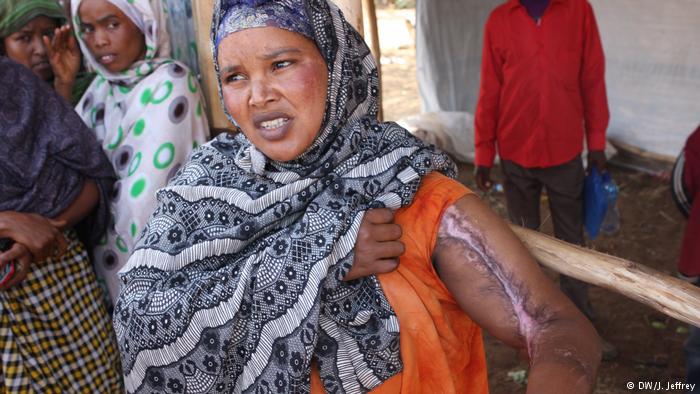Ethiopia has experienced one of its worst population displacements due to violence in recent times. Now stuck in camps, displaced Ethiopians are trying to come to terms with what their future may hold.
The young woman sitting on the warehouse floor in a striking pink abaya remains completely silent as fellow Oromo around her recall the evictions that resulted in about 50,000 of the Oromo ethnic group leaving Ethiopia’s eastern most Somali region.
“She was throttled so badly they damaged her vocal chords,” said a doctor in the industrial park on the outskirts of the city of Harar. About 3,500 of the evicted Oromo are housed here. “She can’t eat anything, only drink fluids,” the doctor added.
At the same time the Oromo were heading west out of the region, ethnic Somalis living in the neighboring Oromia region were heading east. Violent ethnic reprisals tore apart communities that previously had integrated peacefully, often for centuries.
Protests and riots
One of Ethiopia’s largest internal displacements due to violence in recent times was triggered by events on September, 12 in the usually peaceful and bustling trading city of Aweday, between the cities of Harar and Dire Dawa.
On that day, protests by Oromo escalated to rioting that left 18 dead, according to official figures. The majority were Somali traders of khat, a plant that, when chewed, acts as a mild stimulant. The Somali who fled Aweday dispute the number, saying at least 40 were killed.
In the numerous camps that have popped up to absorb the displaced, Oromo and Somali tell equally convincing stories of ethnic violence, primarily carried out, they claim, by each region’s special police forces. They display the scars and wounds to back up their tales of violence.
Mutual accusations
Both regional governments deny that their special police forces were involved. They accuse each other of causing trouble and using unrest for shadowy political ends. At the federal level, the government faces accusations ranging from not doing enough to turning a blind eye, to even abetting violence for political ends too.
“It’s very difficult to tell if there have been acts of omission or commission at all levels,” the head of one international humanitarian organization in Ethiopia, who spoke on condition of anonymity, told DW. It is also possible that the government simply does not have the capacity to effectively counter such widespread violence. Both the displaced Oromo and Somali say that even if federal forces intervene to stop the violence, they are unable to maintain long-term stability and safety.
The role of the diaspora
Meanwhile, accusations go beyond domestic political malice to include the Ethiopian diaspora opposition and social media.”The real Oromo administration is not in this country–it is outside,” said a Somali man who fled Oromia’s southern Bale zone after attacks and looting by Oromo militia. He now lives in a camp housing tens of thousands of displaced Somalis. “They are the trouble makers,” he said.
Whatever, or whoever, may be behind the unrest, the results are all too painfully clear. A woman standing near the man who fled the Bale zone lifted the hem of her dress to reveal scars running up her leg–shrapnel wounds from a grenade local police tossed at her and three other women.
“We’d always lived with the Oromo peacefully until the regional special police force turned up and started burning the houses of Somalis,” she said. “I ran to the local police station with three other women, but the police told us: ‘This is not the day when Somalis are protected’.”
No protection
The grenade was thrown as the women turned to flee. The woman wounded on her leg managed to stagger on after the explosion and escape. But she doesn’t know what happened to the other women. She says she thinks they were caught.
Other Somalis in the camp reported widespread rape and pregnant women miscarrying while being evicted in overcrowded trucks. Others pulled up clothing to reveal old bullet wounds, scars and lesions from burns, broken bones that never healed, and more.
The Oromia and Somali regions are the two largest in the country. They share a border of more than 1,400 km (870 miles). The Oromo are the largest ethnic group in Ethiopia, numbering about 35 million. Other ethnic groups are deeply wary of the Oromo and this applies especially to Ethiopia’s 6.5 million Somalis.
Ethnic conflict along the border between the two regions and in the regional rural hinterlands has been going on for a long time. But ethnic violence in urban areas well removed from the border is rare, and all the more shocking for seemingly coming out of the blue.
In 2004, a referendum to decide the fate of more than 420 kebeles –Ethiopia’s smallest administrative units — around the border gave 80 percent of them to the Oromia Region. This led to thousands of Somalis leaving for fear of repercussions.
Some say the referendum could be one factor behind the current conflict. The other may be the on-going drought, which puts further pressure on pasture and resources, though many observers don’t believe this to be sufficient cause.
“There’s been drought before and no violence happened,” said Abdishakar Adam, vice administrator of one of the Somali regional zones badly hit by the drought. “The main reason is politics and is hidden–this is all man-made.”
How to stop the bloodshed
Ethiopia’s ethnic federalist system devolves power to regional states. Some observers note how this leaves the government in the difficult position of respecting devolution while also protecting the constitutional rights of minorities.
The recent troubles occurred mainly where sizeable minorities live: Somalis in Aweday, for example, and Oromo in the Somali regional capital Jijiga. More diverse cities such as Dire Dawa, with a less clear majority, have escaped violence for now.
“The government must start investigations, hold the political elites involved accountable and arrest the perpetrators,” said a Somali official who spoke on condition of anonymity. “Otherwise the bloodshed will not stop.”



